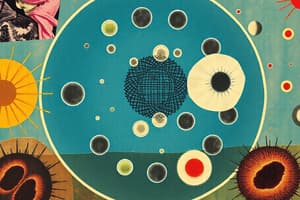Podcast
Questions and Answers
What is the main function of mitochondria in a cell?
What is the main function of mitochondria in a cell?
- Generation of energy through cellular respiration (correct)
- Protein synthesis
- Cell membrane separation
- Storage of genetic material
What type of molecule provides energy, structure, and storage in cells?
What type of molecule provides energy, structure, and storage in cells?
- Lipids
- Nucleic acids
- Proteins
- Carbohydrates (correct)
What is the term for the passing of traits from parents to offspring?
What is the term for the passing of traits from parents to offspring?
- Evolution
- Heredity (correct)
- Inheritance
- Genetics
What is the process by which water is transported in plants?
What is the process by which water is transported in plants?
What is the term for the community of living and nonliving components in an ecosystem?
What is the term for the community of living and nonliving components in an ecosystem?
What is the process by which cells convert light energy into chemical energy?
What is the process by which cells convert light energy into chemical energy?
Flashcards are hidden until you start studying
Study Notes
Cells
- Basic units of life
- Contain genetic material (DNA or RNA)
- Have cell membrane that separates internal environment from external environment
- Can be prokaryotic (no nucleus) or eukaryotic (has nucleus)
Cellular Organelles
- Nucleus: contains genetic material
- Mitochondria: generates energy for cell through cellular respiration
- Endoplasmic reticulum: involved in protein synthesis and transport
- Ribosomes: site of protein synthesis
- Lysosomes: contain digestive enzymes for breaking down cellular waste
Biological Molecules
- Carbohydrates: provide energy, structure, and storage
- Examples: glucose, cellulose, starch
- Proteins: perform various functions, such as enzymes, hormones, and structural components
- Examples: hemoglobin, insulin, collagen
- Nucleic acids: contain genetic information
- Examples: DNA, RNA
- Lipids: provide energy, structure, and insulation
- Examples: triglycerides, phospholipids, cholesterol
Genetics
- Heredity: passing of traits from parents to offspring
- Genes: units of heredity that carry information
- Alleles: different forms of a gene
- Dominant and recessive genes: impact of alleles on phenotype
- Punnett squares: tool for predicting genotype and phenotype
Evolution
- Change in species over time through natural selection and genetic drift
- Mechanisms of evolution:
- Mutation
- Gene flow
- Genetic drift
- Natural selection
- Evidence for evolution:
- Fossil record
- Comparative anatomy
- Molecular biology
Ecosystems
- Communities of living and nonliving components
- Energy flow: producers, consumers, decomposers
- Nutrient cycling: carbon, nitrogen, water
- Interactions: symbiosis, competition, predation
Biological Processes
- Photosynthesis: conversion of light energy into chemical energy
- Cellular respiration: conversion of chemical energy into ATP
- Fermentation: anaerobic breakdown of glucose
- Transpiration: water transport in plants
Biological Systems
- Nervous system: control and coordination
- Circulatory system: transport of oxygen and nutrients
- Immune system: defense against pathogens
- Digestive system: breakdown and absorption of nutrients
Cellular Structure
- Cells are the basic units of life, containing genetic material (DNA or RNA)
- Cells have a cell membrane that separates the internal environment from the external environment
- Cells can be prokaryotic (no nucleus) or eukaryotic (has a nucleus)
Cellular Organelles
- Nucleus: contains genetic material
- Mitochondria: generates energy for the cell through cellular respiration
- Endoplasmic reticulum: involved in protein synthesis and transport
- Ribosomes: site of protein synthesis
- Lysosomes: contain digestive enzymes for breaking down cellular waste
Biological Molecules
- Carbohydrates:
- Provide energy, structure, and storage
- Examples: glucose, cellulose, starch
- Proteins:
- Perform various functions, such as enzymes, hormones, and structural components
- Examples: hemoglobin, insulin, collagen
- Nucleic acids:
- Contain genetic information
- Examples: DNA, RNA
- Lipids:
- Provide energy, structure, and insulation
- Examples: triglycerides, phospholipids, cholesterol
Genetics
- Heredity: passing of traits from parents to offspring
- Genes: units of heredity that carry information
- Alleles: different forms of a gene
- Dominant and recessive genes: impact of alleles on phenotype
- Punnett squares: tool for predicting genotype and phenotype
Evolution
- Change in species over time through natural selection and genetic drift
- Mechanisms of evolution:
- Mutation
- Gene flow
- Genetic drift
- Natural selection
- Evidence for evolution:
- Fossil record
- Comparative anatomy
- Molecular biology
Ecosystems
- Communities of living and nonliving components
- Energy flow:
- Producers
- Consumers
- Decomposers
- Nutrient cycling:
- Carbon
- Nitrogen
- Water
- Interactions:
- Symbiosis
- Competition
- Predation
Biological Processes
- Photosynthesis: conversion of light energy into chemical energy
- Cellular respiration: conversion of chemical energy into ATP
- Fermentation: anaerobic breakdown of glucose
- Transpiration: water transport in plants
Biological Systems
- Nervous system: control and coordination
- Circulatory system: transport of oxygen and nutrients
- Immune system: defense against pathogens
- Digestive system: breakdown and absorption of nutrients
Studying That Suits You
Use AI to generate personalized quizzes and flashcards to suit your learning preferences.



